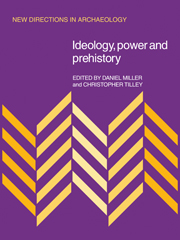Book contents
- Frontmatter
- Contents
- List of contributors
- Preface
- Part one Theoretical perspectives
- Part two Ideology and Power in the Present and Historical Past
- 2 Endo ceramics and power strategies
- 3 Interpreting ideology in historical archaeology: The William Paca Garden in Annapolis, Maryland
- 4 Modernism and suburbia as material ideology
- Part three Ideology and Power in Prehistory
- Part four Conclusions
- Index
2 - Endo ceramics and power strategies
Published online by Cambridge University Press: 05 March 2012
- Frontmatter
- Contents
- List of contributors
- Preface
- Part one Theoretical perspectives
- Part two Ideology and Power in the Present and Historical Past
- 2 Endo ceramics and power strategies
- 3 Interpreting ideology in historical archaeology: The William Paca Garden in Annapolis, Maryland
- 4 Modernism and suburbia as material ideology
- Part three Ideology and Power in Prehistory
- Part four Conclusions
- Index
Summary
The process by which children come to accept the gender-specific associations of everyday objects are considered. The eight basic forms of the Endo ceramic assemblage are described, as used in everyday and in ceremonial contexts. The central role played by some pots in the wedding ceremonies reveal certain associations that may account for the pattern of decorative treatments of the assemblage. Pottery serves both to separate but also to mediate between the spheres of activity and interpretation represented by the two genders. This analysis is reinforced by a consideration of the use of broken pots and raw clay. The pottery forms can thus be related to the assimilation and ritual legitimation of the social order, and in particular, of male dominance. However, both the muted and practical power of women must be considered.
Introduction
The dominant theme of this book is to investigate the kinds of relationships which exist between ideology, representations of power and material culture. In this chapter these relationships will be illustrated by means of a specific case study concerned with the use of pottery by a predominantly agricultural group in Kenya. As will be demonstrated one of the main themes of this study is the suitability of the theoretical approaches advocated (outlined in Chapter 1) to a society divided not by social classes but in terms of sex and age, factors which while being presented in a specific social form, are nevertheless overtly given a biological justification.
- Type
- Chapter
- Information
- Ideology, Power and Prehistory , pp. 17 - 24Publisher: Cambridge University PressPrint publication year: 1984
- 8
- Cited by

